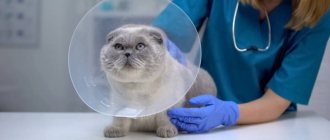During pregnancy, special care for the cat is important, as well as careful monitoring of its condition. The first sign of pathology is bloody discharge, which can accompany the development of diseases in the cat itself and in kittens. In addition, there are several blood release factors associated with physiological processes. In any case, the symptom cannot be ignored.
Causes of discharge
Bleeding in a pregnant cat can be light or heavy. A small amount of blood secreted often goes unnoticed, so it is important to pay attention to other symptoms - poor appetite, wet fur in the tail area, frequent licking of the vagina, restless mood of the pet.
The abundant release of blood from the loop is visible to the naked eye. The symptom can accompany a number of different pathological processes:
- inflammatory diseases of the genitourinary system, including the uterus, are accompanied by infection with pathogens that cause inflammation and bleeding;
- involuntary abortion - against the background of chronic diseases of the cat’s heart, lungs, kidneys, as a result of an incorrect approach to nutrition, with abnormalities in the development of the offspring, trauma to the uterus;
- Trauma to the uterus is a common cause of bleeding in cats during pregnancy; it occurs as a result of jumping, hitting, or falling. Most often, the pathology ends in abortion, with a high risk of death for the mother;
- intrauterine death of offspring develops against the background of infection of the genital organs, in the presence of developmental anomalies, placental insufficiency and other pathologies;
- placental abruption.
Also read the article about different types of discharge during pregnancy in cats.
Rectal injuries
Bleeding from the rectum in these animals is accompanied by staining of the stool with scarlet blood. The most common cause of this phenomenon is damage to the mucous membrane of the organ by too hard feces, which contain the remains of incompletely digested food, hair that got into the stomach during licking, and bone fragments. In older pets, this problem can arise as a result of various pathologies of the rectum (for example, prolapse, cracks, malignant neoplasms).
The danger of discharge according to the stages of pregnancy
During a normal pregnancy, there should be no bleeding throughout the entire period. Light bleeding during the prenatal period is allowed, one or two tablespoons. In this case, the blood should not have a dark or light color, additional pathological impurities and a specific or unpleasant odor.
Blood loss in the early stages of pregnancy indicates the presence of pathology and most often accompanies spontaneous abortion.
The appearance of a daub with an unpleasant odor, mixed with a greenish, brown tint may indicate a serious pathology of pregnancy and childbirth. This condition requires contacting a veterinarian.
Also read about how long a cat walks while pregnant.
Tumor formations in the intestines
The appearance of blood from the pet's anus is one of the symptoms of neoplasms in the intestines. Such tumors are rarely diagnosed in cats and often have a poor prognosis. The sooner the cat's owner seeks veterinary help, the higher the likelihood of successful treatment of the animal. The causes of this disease are not fully understood. In the course of research, it was possible to establish that representatives of the Siamese breed have a predisposition to intestinal cancer.
Most often, these animals have such types of formations as nutritional lymphoma, intestinal adenocarcinoma and mastocytoma. The disease is accompanied by the following symptoms:
- loss of appetite;
- weight loss;
- nausea and vomiting;
- stomach ache;
- pallor of the mucous membranes;
- lethargy, apathy;
- bloody diarrhea.
Normal and dangerous discharge
The first three weeks may be accompanied by pale pinkish discharge from the vagina; such a symptom, as a rule, is not a sign of any pathology and does not require treatment.
On the eve of delivery, mucus begins to leak, which can acquire a yellowish or greenish tint without an unpleasant odor. With the onset of contractions, blood begins to be released. Normally, its volume is from one to two tablespoons, depending on the weight of the cat, and the duration of bleeding does not exceed 10 minutes. The discharge has a normal color - not dark and not too light, without green or brown impurities.
We recommend reading the article about whether a pregnant cat can be sterilized.
The discharge of blood from the loop in a pregnant cat can signal many pathologies. Depending on the cause, the pathological fluid will differ in its characteristics.
- Bleeding lasting more than ten minutes, accompanied by the release of bright scarlet blood, is most often a sign of trauma to the uterus. In this case, the pathology is characterized by heavy blood loss - more than two tablespoons. The clinical picture is represented by lethargy of the cat, increased breathing, which is subsequently replaced by a decrease in breathing, and tachycardia. Massive blood loss leads to the death of the animal, so this condition is an indication to contact a specialist.
- A viscous green secretion may accompany intrauterine fetal death. The condition can be complicated by infection of the cat’s internal organs, sepsis and lead to death. The pathology requires prompt extraction of the offspring through surgery.
- Dark or dark brown fluid from the cat’s genital tract, which appears at various stages of pregnancy, is most often a sign of placental abruption, intrauterine death of the offspring. Both pathologies pose a threat to the pet’s life, so you should seek the help of a specialist. Treatment will depend on the individual characteristics of the animal, the cause of the pathological discharge and other factors. A wait-and-see approach with medication, induction of labor, or cesarean section may be chosen.
- The appearance of pus from the genital tract accompanies infectious diseases. Lack of therapy can lead to the death of offspring, sepsis and other complications, so the owner should contact a veterinarian. Treatment depends on the severity of the disease and the condition of the fetus. Both a course of antibiotic therapy and artificial termination of pregnancy may be prescribed.
Also read the article on how to tell if your cat is pregnant.
General information
Let’s immediately deal with one important nuance. There is discharge during pregnancy, and there is immediate prenatal discharge. If your cat has any “leaking” from the external genitalia, and there is still a month left before giving birth, immediately take your pet to the veterinarian. Discharge during such a period is an unambiguous pathology, indicating the presence of inflammatory processes in the organs of the cat’s reproductive system.
Discharge that appears shortly before birth does not pose any danger. It is very likely that your pet is simply losing a mucus plug from the cervix. This can happen about three days before giving birth. If mucous discharge appears much earlier than this period, you should contact a veterinarian. Early removal of the plug does not bode well for either the cat or her offspring.
Mucus plug, what is it and what is it for?
Any animal lover who has experienced childbirth in their pets at least once probably knows about the existence of the cervix. This is the tubular part of the organ, the function of which can be compared with the intestinal sphincters, for example. In the normal state (when the cat is not pregnant), the cervix is always tightly closed due to contraction of muscle tissue. This reliably prevents pathogenic and conditionally pathogenic microflora from entering the organ cavity.
The uterus must always and in all cases remain sterile! Everything else is a deviation from the norm.
At the time of birth, a certain number of microbes may enter the organ cavity, but, as a rule, the body is able to cope with them on its own.
True, there is one nuance. During pregnancy, the cervix is no longer closed so tightly. This is due to the fact that subsequently the organ will still have to relax, since otherwise the cat will not be able to give birth. It is at this time that the mucous plug acquires special significance: it serves as a “plug” that does not allow dirt and microorganisms into the organ cavity.
Cork is impenetrable to air and other environmental factors. Damage to it during pregnancy is always fraught with a number of extremely unpleasant consequences. In cases where the integrity of the “plug” is broken in the last three to five days before birth (brown mucus), nothing bad will happen. This is a completely physiological phenomenon, and it poses no danger either to the cat itself or to its offspring.
But in situations where the plug is damaged long before childbirth, this does not bode well: pathogenic and conditionally pathogenic microflora, dirt and other negative environmental factors enter the cavity of the pregnant uterus. All this leads to the development of severe inflammatory processes.
Signs of mucous plug coming off before childbirth
If the cat is fairly clean and regularly licks the genital area (and right before giving birth, she does this all the time), then you may not notice anything. But the classic signs of a mucous plug coming off is the appearance of mucous discharge from the external genitalia . Normally they are pink, but may have a reddish-pinkish or even brown color. Let us emphasize once again that this is a completely normal phenomenon, and it does not pose any danger to the health and life of the animal.
But with normal prenatal discharge, the animal’s behavior should also remain normal. Since the animal senses the approaching birth, it becomes restless and constantly runs around the house in search of the most suitable place for kittens.
If something is wrong, the cat may meow “hysterically,” avoid contact with the owner, and react inadequately to attempts to palpate its stomach. If such signs appear, you should immediately contact a veterinarian.
What to do if your pregnant cat is bleeding
If a pregnant cat experiences bleeding that lasts more than ten minutes and exceeds the permissible amount, you should contact your veterinarian. Untimely treatment can lead to the death of not only the fetus, but also the cat.
The doctor will prescribe the necessary studies that will help make the correct diagnosis and choose treatment tactics.
To avoid bleeding from your cat during pregnancy, you must:
- monitor the animal’s nutrition;
- check the condition of the loop and hair in the tail area for traces of pathological discharge;
- do not expose your pet to stress;
- avoid traumatizing the cat’s abdomen;
- Avoid hypothermia and overheating of the animal.
1111
How to treat?
The owner needs to be close to the pet at such an important moment and monitor so that no complications occur.
Clear, light pink bleeding before childbirth is considered normal, so treatment is not required. The owner needs to monitor the pet’s condition, calm her down during childbirth, and do everything to ensure that the process ends safely. At the same time, during childbirth, it is important to pay attention to the nature of the amniotic fluid, color, and smell. If you have any suspicions, it is better to tell everything to the veterinarian, who will refer you for additional examination and, if necessary, prescribe restorative treatment.
In case of uterine abruption, when bloody discharge comes from under the tail, the doctor first of all takes into account the timing of pregnancy. In the later stages, constant monitoring is carried out, and comprehensive analyzes are carried out. Delivery usually occurs without complications unless the animal has other health problems. If abruption occurs in the first half of pregnancy, and the bleeding is profuse, there is no other choice but to artificially induce labor, since the cat may die.
No less dangerous than bloody discharge are purulent discharges, which are often the result of the death and decomposition of one or more fetuses. In such situations, the veterinarian prescribes effective antibiotics and other drugs to avoid complications. If the condition does not return to normal, the doctor will suggest a cesarean section or termination of the pregnancy to save the animal’s life. After surgical treatment or urgent induction of labor, long-term rehabilitation under the supervision of a physician will be required.











